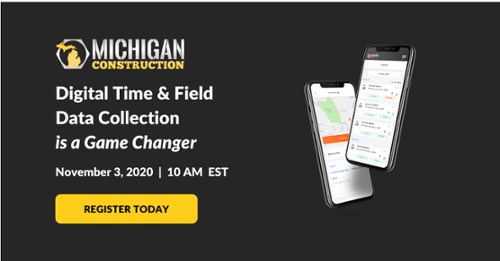![LinkedIn Promo Graphics [Social] (11)](https://blog.michiganconstruction.com/hs-fs/hubfs/LinkedIn%20Promo%20Graphics%20%5BSocial%5D%20(11).png?width=790&height=413&name=LinkedIn%20Promo%20Graphics%20%5BSocial%5D%20(11).png)
While the construction industry has lagged in technology adoption, factors like labor shortages, a pandemic, and new technology options have created the urgency for leaders to innovate.
With so many moving parts and variables during projects, leaders need quick and accurate data to make decisions – like choosing which crew is right for a job and the assets needed. Leveraging mobile field technology can improve your bottom line, wow your customers, and help you win important new work.
While you may have noticed that your competition and other trade leaders have adopted digital tools, you don’t want to let FOMO drive a decision to have everyone go download an app. The ultimate question to ask yourself: How can I measure a return on my investment for this asset?
Sound familiar?
It’s the same logic you use to determine which tools of your trade to purchase– and it can be applied to investing in technology. Just like a large piece of equipment, you can investigate and plan for the total cost of ownership along with the total return of software.
Building the Business Case for Mobile Field Technology
Implementing an automated workflow is usually an important change for a construction company. It takes money, time and effort to adopt new processes and tools that will sync your job sites with your back office team, giving decision-makers real time data.
Estimating an ROI gives you peace of mind that you have a true business case for the change.
Fortunately, most firms find that automating a few key processes can have a big impact.
When estimating your own ROI, you can break down savings into three different categories:
- Direct savings that are easy to calculate
- Indirect savings to estimate
- New revenue opportunities that are real, but are more difficult to measure
How to Calculate Direct Savings
The easiest ROI value to identify is time saved directly from using a digital tool instead of an outdated or redundant process. Consider when mobile field technology can turn manual effort (like time tracking or other forms) into streamlined processes that reduce entry time in the field and eliminate duplicate data entry in the office.
These employee time savings can result in simple ROIs to calculate, for example:
- An employee typically takes 5 hours per week to complete and submit a daily form.
- Now, she will only need 2 hours a week to do the same work once your streamlined digital workflow is in place.
- That’s a time saving of 3 hours.
- Multiple 3 hours by the employee’s loaded hourly rate to estimate the weekly savings.
- Multiply this amount by the number of people/crews impacted at that same rate.
- Apply this estimate to the total savings your new software tool will generate over a given time frame (typically yearly) and over its lifetime.
- Repeat for each type of employee directly impacted — both field and office.
Want to hear real-world stories of Michigan construction firms leveraging these tools? Join our free webinar November 3rd at 9:00am: Digital Time and Field Data Collection is a Game Changer [REGISTER NOW]
Indirect savings
What costly mistakes will the new software reduce? Many firms identify scheduling as a large challenge to solve and to communicate. Can your new system reduce double booking or other scheduling errors? How much could reducing those errors save you?
Other “low hanging fruit” with mobile technology are safety forms. Will the new software help you reduce the time your team takes dealing with safety and compliance? Will it reduce penalties and fines from non-compliance?
New Revenue Opportunities and Other Factors (Less Tangible, but Still Real)
While parts of ROI estimations are straightforward, other parts don’t translate nicely into calculated dollars.
What’s the opportunity of implementing simple software that works the way your business works? Manual data entry is a tedious task that wastes time. Once eliminated by a better solution, what more productive tasks could your best people be doing? These higher level tasks can open up additional revenue.
Leveraging mobile and digital tools can also solidify your reputation as being a forward-thinking company. This can lead to better recruitment and business development opportunities.
Easy-to-use tech not only saves employee time, but it can also result in a happier team (less swearing at that spreadsheet pivot table actually feels rather tangible…) Small wins like this add up and can lead to your company being a more pleasant place to work. And, that has its own value for retaining your best people.
How to Calculate Your ROI [DIY Worksheets]
To help you estimate your ROI for new technology, SPARK has two spreadsheets to guide you through the process. We’ve built these from our experience helping hundreds of trade contractors implement easy, fast, and simple digital tools to work the way their business needs.
- Download our ROI Estimating Tool to brainstorm the different cost savings areas for your business.
- Next, download this ROI spreadsheet to start calculating numbers and see your estimated ROI.
Building Semi-Custom Field Data Tools
A few simple ROI exercises can solidify your decision. After that, you can start thinking about the best solution for your business.
As a software company serving the construction industry, we are referred to new clients because of these measurable results. At SPARK, 90% of our clients start seeing returns on their projects within 12 months!
Next, we’ll explain the benefits of semi-custom software, and how it could be the right technology approach for your company.

